
San Francisco Bay Area, California 408 227-5767
Welcome to the website of Citizens Concerned About Chloramine (CCAC), a nonprofit organization based in the San Francisco Bay Area, California.
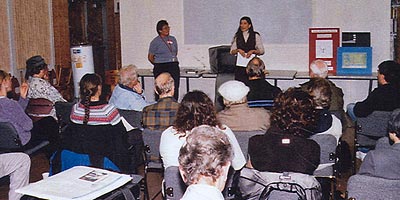
CCAC Vice-President Linda Corwin, left, and President Denise Johnson-Kula, right, speak to a group of citizens in Pacifica, CA about chloramine in the water supply.
Contents of Home Page (click on an item):
-
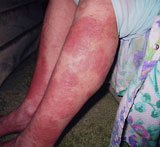
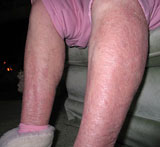 Left: rash which developed on woman in Mountain View, CA, after introduction of chloramine in February 2004. Photo taken August 25, 2006. Right: same legs after avoiding tap water beginning September 2006. Photo taken December 19, 2006.
Left: rash which developed on woman in Mountain View, CA, after introduction of chloramine in February 2004. Photo taken August 25, 2006. Right: same legs after avoiding tap water beginning September 2006. Photo taken December 19, 2006.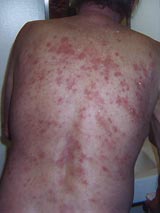
 Left: rash which developed on man after introduction of chloramine in Vermont in April 2006. Photo taken August 2006. Right: improvement after showering regularly in an area where chloramine is not used, beginning January 23, 2007. Photo taken March 19, 2007. For more and larger photos of skin conditions, see Photo Gallery II.
Left: rash which developed on man after introduction of chloramine in Vermont in April 2006. Photo taken August 2006. Right: improvement after showering regularly in an area where chloramine is not used, beginning January 23, 2007. Photo taken March 19, 2007. For more and larger photos of skin conditions, see Photo Gallery II.
Officials end consideration of chloramines for water treatment in Charlottesville-Albemarle's water supply (Virginia).
July 25, 2012http://www.cvilletomorrow.org/news/article/12532-chloramines/
Tulsa City Council Requests Delay in Switch to Chloramine
The Tulsa Metropolitan Utility Authority (TMUA) plans to switch to chloramine to meet EPA standards for disinfection byproducts.
On October 27, 2011, the Tulsa, Oklahoma City Council heard a presentation on chloramine by Robert Bowcock of Integrated Resource Management, a consulting firm involved in water-related issues. His experience includes working as a water utility manager, and designing and constructing water treatment and distribution systems. He works with environmental advocate and attorney Erin Brockovich.
In his presentation, he pointed out the disadvantages of chloramine and suggested alternative ways to meet the EPA standards.
After the presentation, the council requested (by a vote of 7-2) that the TMUA delay the planned switch, to allow time for Robert Bowcock to meet with TMUA to consider alternatives to chloramine.
See a video of the Tulsa City Council meeting, October 27, 2011 (the meeting begins at 1:30:10 and ends at 3:02:00)The TMUA meeting on December 14, 2011 was attended by more than 140 opponents of the switch to chloramine who packed the room. At the meeting, Robert Bowcock argued that the city can extend the use of its existing granular activated carbon system, rather than switch to chloramine.
Chloramine in South Carolina
See a November 10, 2011 video and article Tap Water: Running A Risk? from WSPA News Channel 7 in South Carolina, reporting that Michelle Anderson's stomach cramps and rashes disappeared after years of suffering. She discovered her water contained chloramine so stopped using it. Also included:
- results of the reporter's investigations into the known and unknown health effects of chloramine, with the EPA and leading allergists and dermatologists
- interviews with water officials in South Carolina who use chloramine
- an interview with Dr. Michael Plewa who studies nitrosamines such as NDMA, disinfection byproducts of chloramines that are not currently regulated but, in his opinion, should be because of their toxicity—potentially much more serious than stomach cramps and rashes
- a report on the state of Tennessee which requires having free chlorine in water systems, and chooses not to use chloramine because there is too much unknown about it.
Spill of Chloraminated Drinking Water into Polhemus Creek Kills Steelhead Trout
Read the article, "Utility fined for spilling chemicals into Polhemus Creek, killing steelhead trout" by Julia Scott, which appeared in the San Mateo County Times on May 31, 2009. Following are some excerpts:
"That's the funny thing: People think of drinking water as not being a problem, but when you see the reaction with the species in the creek you realize it can be toxic," said Dyan Whtye, assistant executive officer at the Regional Water Quality Control Board.
The spills occurred Sept. 25 and Sept. 27, 2007. The first lasted 45 minutes, but the second spill was undetected for seven hours.
It was only after SFPUC biologists began noticing the dead fish and alerted Cal Water about the magnitude of the chemical spill that the water company took action, according to the complaint.
The spills occurred Sept. 25 and Sept. 27, 2007. The first lasted 45 minutes, but the second spill was undetected for seven hours.
It was only after SFPUC biologists began noticing the dead fish and alerted Cal Water about the magnitude of the chemical spill that the water company took action, according to the complaint.
For more on chloramine fish kills, see Effects on the Environment.
SFPUC Citizens' Advisory Committee Urges Scientific Testing of the Immediate, Acute, and Long-Term Health Effects of Chloramine
The Water Subcommittee of the Citizens' Advisory Committee (CAC) of the San Francisco Public Utilities Commission (SFPUC) drafted a resolution on chloramine disinfection, and passed it (by the full CAC) on November 17, 2008. Some excerpts:
WHEREAS, no agency, including the United States Environmental Protection Agency (USEPA), has done scientific studies to determine whether chloramine, when used as a secondary disinfectant, might cause adverse skin, respiratory, or digestive effects in human beings; and
WHEREAS, there have not been epidemiological or other scientific studies on the dermal, respiratory, and digestive effects of human exposure to chloraminated drinking water, even as the use of chloramine for secondary disinfection is increasing in the United States; and
BE IT RESOLVED that the SFPUC Citizens Advisory Committee urges the SFPUC and the San Francisco Department of Health (SFDPH) to petition the United States Environmental Protection Agency (USEPA) to conduct scientific testing of the immediate, acute, and long-term health effects of chloramine and other practical alternatives, when used as used as a secondary water disinfectant.
WHEREAS, there have not been epidemiological or other scientific studies on the dermal, respiratory, and digestive effects of human exposure to chloraminated drinking water, even as the use of chloramine for secondary disinfection is increasing in the United States; and
BE IT RESOLVED that the SFPUC Citizens Advisory Committee urges the SFPUC and the San Francisco Department of Health (SFDPH) to petition the United States Environmental Protection Agency (USEPA) to conduct scientific testing of the immediate, acute, and long-term health effects of chloramine and other practical alternatives, when used as used as a secondary water disinfectant.
To see the full text of the resolution, and a letter sent by the SFPUC to the EPA (dated March 11, 2009) as a result, click here. To see a follow-up letter from Citizens Concerned About Chloramine to EPA Administrator Lisa Jackson (dated May 11, 2009), click here.
Citizens Testify Before the SFPUC on Health Effects of Chloramine
To see a video of the February 24, 2009 meeting of the San Francisco Public Utilities Commission, click on the following:
http://sanfrancisco.granicus.com/MediaPlayer.php?view_id=22&clip_id=7300.
The chloramine-related portion of the meeting is item 10 on the agenda; citizen testimony is at the end.New Research: Chloramine Disinfection Byproducts More Toxic Than Those of Chlorine
New research published in 2007 by Dr. Michael Plewa, a professor at the University of Illinois, shows that the disinfection byproducts (DBPs) created from the use of chloramine are much more toxic than the DBPs of chlorine. These new nitrogen-containing DBPs are currently not regulated by the EPA.
They are in California water supplies and he recommends that water agencies switch back to chlorine.
See the article "Anna Eshoo takes up chloramine question" by Daniel DeBolt. Also see the abstract for the research paper on haloacetonitriles by Dr. Plewa and others.CCAC Meets with Federal Lawmakers to have Chloramine Removed From the Water Supply
CCAC is meeting with all federal lawmakers in the San Francisco Bay Area to ask the EPA to stop using chloramine as our water disinfectanct, and return to the use of chlorine,
since the disinfection byproducts of chloramine are more toxic than those of chlorine, and health studies on chloramine have never been conducted.On July 3, 2007, CCAC met with the staff of U.S. Representative Anna Eshoo. Her staff initiated a congressional research service investigation of the matter and confirmed that there are no skin, respiratory, digestive (including food exposure), or epidemiologic studies on chloramine. She also arranged a meeting between CCAC and the state EPA on September 5 to discuss the possibility of a waiver to return to the use of chlorine. Staff from the San Francisco Public Utilities Commission, the San Francisco Public Health Department, and the state health department also attended. See the Article Archive for "Anna Eshoo takes up chloramine question" by Daniel DeBolt, which appeared in The Almanac (Menlo Park) on August 29.
CCAC gave a presentation on chloramine to U.S. Representative Tom Lantos and his staff on August 30.
CCAC also met with the staffs of
Representative Zoe Lofgren on September 11,
Representative Ellen Tauscher on September 17,
Representative Pete Stark on September 19, and
Representative Mike Honda on September 24.
Meetings with other lawmakers, both federal and state, are being arranged.
CCAC recommends that all those affected by and concerned about chloramine contact their federal and state lawmakers, including U.S. Senators Barbara Boxer and Dianne Feinstein.
Following are quotes from a letter to VCE about health effects from chloramination, from Dr. David Ozonoff, Professor of Environmental Health and Chair Emeritus, Department of Environmental Health, Boston University School of Public Health:
CCAC recommends that all those affected by and concerned about chloramine contact their federal and state lawmakers, including U.S. Senators Barbara Boxer and Dianne Feinstein.
National Effort
An environmentalist group from Vermont, Vermonters for a Clean Environment (VCE), along with Vermont People Concerned About Chloramine (PCAC), have joined CCAC in the national effort to challenge EPA regulations.Following are quotes from a letter to VCE about health effects from chloramination, from Dr. David Ozonoff, Professor of Environmental Health and Chair Emeritus, Department of Environmental Health, Boston University School of Public Health:
A close temporal relationship between the treatment change and the complaints of water users strongly suggests that one is the cause of the other.
At the same time that a water supply is an efficient means to deliver a health-giving substance, it is also an efficient means to distribute harmful ones.
In any event, health complaints from water users attendant upon any treatment change are a red flag and need attention.
At the same time that a water supply is an efficient means to deliver a health-giving substance, it is also an efficient means to distribute harmful ones.
In any event, health complaints from water users attendant upon any treatment change are a red flag and need attention.
Vermont Senate Hearings on Chloramine
In Vermont, more than 180 residents have reported chloramine-related symptoms to lawmakers and People Concerned About Chloramine (PCAC), a local citizens' group. On March 22-23, 2007 the Vermont Senate Committee on Health and Welfare
heard testimony on the use of chloramine. They questioned the Vermont Department of Health, the Champlain Water District, which provides water to about 68,000 residents, and PCAC. They also talked to CCAC President Denise Johnson-Kula by phone from California.See the Article Archive for "Senate Checks Out Health Impact of New Water Additive" by Ken Picard, which appeared in the Seven Days webweekly on March 28.
Vermont Citizens Testify on Health Effects of Chloramine
Watch videos of Vermont citizens telling of their experiences with chloramine to the Centers for Disease Control, Environmental Protection Agency, Vermont Department of Health, State Legislators and reporters, on September 26, 2007. http://www.vce.org/chloraminevideos.html.Lead Exceeds Actionable Levels in some Los Altos Hills Homes Receiving Chloraminated Water
The Purissima Hills Water District (Los Altos Hills, CA), which purchases water from the San Francisco Public Utilities Commission (SFPUC), distributed a pamphlet to its customers which reports that "some homes in the community have lead levels above the state and federal action level of 15 parts per billion (ppb)". See the Article Archive for an article that appeared in the Los Altos Town Crier on February 28, 2007, followed by the pamphlet.Lead in the drinking water of Washington, D.C., Maui (Upper Kula), and North Carolina has been linked to chloramine in the drinking water; see the Article Archive. The SFPUC switched to chloramine in February 2004.
SFPUC Fails to Report on Health Studies on Chloramine
To read about
public testimony on health effects of chloramine before the San Francisco Public Utilities Commission (SFPUC), the SFPUC's resolution to search for health studies, and their subsequent failure to follow through,
click here (photos and video available).
It is vitally important to get the word out about chloramine. For many people, Citizens Concerned About Chloramine (CCAC) is the only hope for relief from unexplained skin, respiratory, or digestive symptoms. CCAC has heard from over 400 people in the San Francisco Bay Area with symptoms, often quite serious. CCAC has also heard from people dealing with chloramine in Maui, Los Angeles, San Diego,
Colorado,
Florida,
Georgia,
Kansas,
Louisiana,
Maine,
Massachusetts,
New Hampshire,
New York,
Ohio,
Oklahoma,
Oregon,
South Carolina,
Texas,
Vermont,
Virginia,
Washington, D.C.,
and Scotland. People are often extremely grateful to have found this website and connect with others experiencing the same problems.
Your donations are needed to support CCAC! Expenses include research, computers, internet connection, telephone, photocopying, postage, website hosting and maintenance, and more. CCAC officers, including the president who works full time and more, are unpaid. The only funding for the organization comes from members and donations.
Donations are gratefully accepted in any amount. (At this time, contributions are not tax-deductible.) Make checks payable to "CCAC", then mail to Denise Johnson-Kula, Citizens Concerned About Chloramine, 6162 Cottle Road, Suite #11, Building B, San Jose, CA 95123.
Your donations are needed to support CCAC! Expenses include research, computers, internet connection, telephone, photocopying, postage, website hosting and maintenance, and more. CCAC officers, including the president who works full time and more, are unpaid. The only funding for the organization comes from members and donations.
Donations are gratefully accepted in any amount. (At this time, contributions are not tax-deductible.) Make checks payable to "CCAC", then mail to Denise Johnson-Kula, Citizens Concerned About Chloramine, 6162 Cottle Road, Suite #11, Building B, San Jose, CA 95123.
On February 2, 2004, without any public discussion or consent and without adequate notification, chloramine, (a combination of chlorine and ammonia) was added to the Hetch Hetchy water supply by the San Francisco Public Utilities Commission (SFPUC). (The SFPUC distributes water to the San Francisco peninsula, from San Francisco in the North to Sunnyvale in the South.)
Chloramine replaced chlorine, a long-used, well-tolerated and extensively studied water disinfectant.
The SFPUC claims that chloramine is more effective than chlorine in getting rid of pathogens and lowering possible carcinogens in the water, i.e. trihalomethanes. Although the Environmental Protection Agency (EPA) now requires utilities like the SFPUC to lower the levels of trihalomethanes, the EPA never mandated the use of chloramine. There are other alternatives. Chloramine is an attractive choice because it is easy to make and one of the least expensive disinfectants in a list of 15 EPA options.
However, chloramine is a much less effective disinfectant than chlorine. And unlike chlorine, chloramine itself has not been studied for its human health effects. In industry, it is well known that chloramine is a skin and respiratory irritant. Yet, according to the EPA, NO dermal or inhalant studies on the effects of chloramine as used as a water disinfectant have ever been conducted. Furthermore, the handful of cancer studies done on chloramine to date are so limited that they are considered INADEQUATE for assessment.
Despite the lack of studies, many major water utilities in California and across the country are now using chloramine. Most have switched only recently. In addition to the SFPUC, other water utilities in California that have switched include East Bay Municipal Utilities District, Marin Municipal Water District, Contra Costa Water District, Alameda County Water District, Santa Clara Valley Water District, and Metropolitan Water District of Southern California. The EPA projects that over 90% of water utilities nation-wide will be using it in the next few years.
The SFPUC claims that chloramine is more effective than chlorine in getting rid of pathogens and lowering possible carcinogens in the water, i.e. trihalomethanes. Although the Environmental Protection Agency (EPA) now requires utilities like the SFPUC to lower the levels of trihalomethanes, the EPA never mandated the use of chloramine. There are other alternatives. Chloramine is an attractive choice because it is easy to make and one of the least expensive disinfectants in a list of 15 EPA options.
However, chloramine is a much less effective disinfectant than chlorine. And unlike chlorine, chloramine itself has not been studied for its human health effects. In industry, it is well known that chloramine is a skin and respiratory irritant. Yet, according to the EPA, NO dermal or inhalant studies on the effects of chloramine as used as a water disinfectant have ever been conducted. Furthermore, the handful of cancer studies done on chloramine to date are so limited that they are considered INADEQUATE for assessment.
Despite the lack of studies, many major water utilities in California and across the country are now using chloramine. Most have switched only recently. In addition to the SFPUC, other water utilities in California that have switched include East Bay Municipal Utilities District, Marin Municipal Water District, Contra Costa Water District, Alameda County Water District, Santa Clara Valley Water District, and Metropolitan Water District of Southern California. The EPA projects that over 90% of water utilities nation-wide will be using it in the next few years.
The introduction of chloramine resulted in a number of adverse health reactions to individuals. These reactions revealed the toxicity of the new additive in the water being piped to Bay area households. Many of the individuals affected had no idea that anything new was being introduced into the water. Many people still do not know of the change. A tiny statement attached to the bottom of a homeowner's water bill was easily missed. Apartment dwellers in a number of cities received no notice at all because they do not pay a separate water bill.
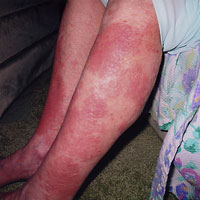
Rash which developed after introduction of chloramine in February 2004. Photo taken August 25, 2006.
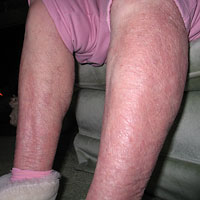
Same legs after avoiding tap water beginning September 2006. Photo taken December 19, 2006. For larger photos and details, and photos of a chloramine-caused rash on a Vermont man's chest, back, and leg, see Photo Gallery II.
Suddenly, a number of people reported experiencing intense burning and itching of their skin during and after washing or bathing in the newly chloraminated water. Many also developed severe dry skin, rashes, welts and blisters. When these individuals stopped using their chloraminated tap water and substituted non-chloraminated water sources such as bottled spring water, their symptoms went away.
Other people developed respiratory symptoms from exposure to the chloraminated water (especially after showering and bathing). These symptoms ranged from severe sinus congestion, sneezing, coughing, choking and wheezing to severe asthma, breathing difficulties and loss of consciousness from asphyxiation. The worst respiratory symptoms occurred during or after bathing or showering in chloraminated water. Again when these individuals stopped using the chloraminated water their symptoms cleared up.
There were also people who began experiencing severe dry eye, mouth, and throat, excessive peeling and chapping of the lips, and digestive problems. All these symptoms were alleviated when the chloraminated water was avoided.
In addition, there were reports of fish and other aquatic species dying after water mains broke, spilling chloraminated water into streams and other waterways (including creeks in areas served by the East Bay Municipal Utilities District, Marin Municipal Water District, and the Lower Mainland of British Columbia in Canada-- see the Assessment Report - Inorganic Chloramine). Also, there were reports of expensive plumbing damage due to the corrosive effects of chloramine.
Other people developed respiratory symptoms from exposure to the chloraminated water (especially after showering and bathing). These symptoms ranged from severe sinus congestion, sneezing, coughing, choking and wheezing to severe asthma, breathing difficulties and loss of consciousness from asphyxiation. The worst respiratory symptoms occurred during or after bathing or showering in chloraminated water. Again when these individuals stopped using the chloraminated water their symptoms cleared up.
There were also people who began experiencing severe dry eye, mouth, and throat, excessive peeling and chapping of the lips, and digestive problems. All these symptoms were alleviated when the chloraminated water was avoided.
In addition, there were reports of fish and other aquatic species dying after water mains broke, spilling chloraminated water into streams and other waterways (including creeks in areas served by the East Bay Municipal Utilities District, Marin Municipal Water District, and the Lower Mainland of British Columbia in Canada-- see the Assessment Report - Inorganic Chloramine). Also, there were reports of expensive plumbing damage due to the corrosive effects of chloramine.
CCAC Founded, June 30, 2004
Soon after chloramine was introduced into the water supply, Citizens Concerned About Chloramine (CCAC) was founded. On June 30, 2004, Denise Johnson-Kula who was severely affected by the chloramine, was joined by eleven other individuals who had also experienced the adverse reactions. They decided to take action to help those suffering the symptoms.

Today, CCAC has hundreds of members and has become an active and strong advocate for the removal of chloramine from the water supply to eliminate the harmful effects of chloramine. It became a non-profit organization on May 30, 2005, and was incorporated on July 14, 2005. It is a non-partisan group working with those who are concerned about chloramine in the water supply and its damaging effect to human health, to the environment and to plumbing.
CCAC has begun to hear from people experiencing symptoms from chloramine in other parts of the country, including Maui, Los Angeles, San Diego, Vermont, New York, Florida, Texas, Colorado, Louisiana, Maine, New Hampshire, Ohio, Massachusetts, Kansas, and Georgia. We have even heard from people in Scotland, where chloramine was introduced in 2004.
Goals of CCAC
Soon after chloramine was introduced into the water supply, Citizens Concerned About Chloramine (CCAC) was founded. On June 30, 2004, Denise Johnson-Kula who was severely affected by the chloramine, was joined by eleven other individuals who had also experienced the adverse reactions. They decided to take action to help those suffering the symptoms.

Today, CCAC has hundreds of members and has become an active and strong advocate for the removal of chloramine from the water supply to eliminate the harmful effects of chloramine. It became a non-profit organization on May 30, 2005, and was incorporated on July 14, 2005. It is a non-partisan group working with those who are concerned about chloramine in the water supply and its damaging effect to human health, to the environment and to plumbing.
CCAC has begun to hear from people experiencing symptoms from chloramine in other parts of the country, including Maui, Los Angeles, San Diego, Vermont, New York, Florida, Texas, Colorado, Louisiana, Maine, New Hampshire, Ohio, Massachusetts, Kansas, and Georgia. We have even heard from people in Scotland, where chloramine was introduced in 2004.
Goals of CCAC
- To educate the public about the effects of chloramine on human health and the damage to the environment and to plumbing.
- To discontinue the use of chloramine until the health studies that have NEVER been done are completed.
- To have the water utilities implement the World Health Organization's recommendation to reduce trihalomethanes by removing organic matter through prefiltration, before final disinfection with chlorine. This is a much better solution than using chloramine to reduce trihalomethanes.
Note: Organic matter is a precursor to the formation of trihalomethanes, a possible but not proven carcinogen. Removing organic matter prevents the formation of trihalomethanes in the first place. This allows the use of chlorine and takes best advantage of its superior disinfection capabilities. Chlorine is much more effective at killing disease causing organisms than chloramine. Chlorine has been well tolerated for decades, is easily and inexpensively filtered out, and has been studied extensively. For a more complete explanation, see the WHO report, "Guidelines for Drinking Water Quality (PDF, 145 KB)."
- mission statement of the CCAC
- reported health effects from the use of chloramine
- chloramine fact sheets
- CCAC literature available for download
- selected research studies and links
- articles, letters, and links to the internet
- suggestions on what you can do to help
- contact information to reach CCAC, and to report your symptoms
- Lawmaker contacts
- suggestions for Writing Letters to the Editor
We hope that your visit is informative and productive!